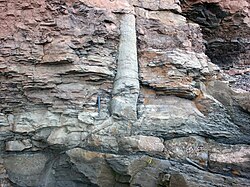| Stigmaria | |
|---|---|
 | |
| Stigmaria, a fossil lycopsid rhizome | |
| Scientific classification | |
| Kingdom: | Plantae |
| Clade: | Tracheophytes |
| Clade: | Lycophytes |
| Class: | Lycopodiopsida |
| Order: | † Lepidodendrales |
| Genus: | † Stigmaria Brongn. |
Stigmaria is a form taxon for common fossils found in Carboniferous rocks. [1] They represent the underground rooting structures of arborescent lycophytes such as Sigillaria and Lepidodendron under the order Lepidodendrales.






